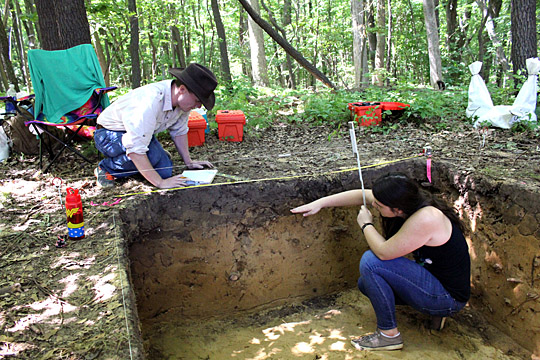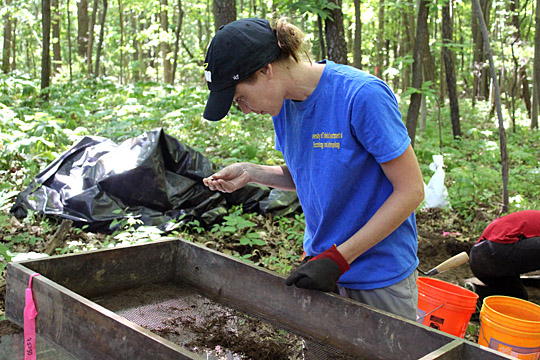If you walk the red trail at Wildwood Preserve Metropark, you may catch a glimpse of University of Toledo students armed with shovels, trowels and dust pans on an archaeological dig.
Dr. Melissa Baltus, archaeologist and assistant professor of anthropology, is running the UT Archaeological Field School on a flat terrace overlooking I-475 as a summer class to combine hands-on learning of archaeology techniques and local history research.

Recent UT graduate Michael Campbell and UT junior Brianna Geer took measurements at the excavation site at Wildwood Preserve Metropark.
With permission from the Metroparks of the Toledo Area and the Ohio Historic Preservation Office, the UT class is testing the area for evidence of past human habitation, such as house structures or refuse pits.
“Metroparks encourages research, especially where findings will continually build on existing knowledge and assist in the dissemination of information through education,” said Karen Menard, research and monitoring supervisor for Metroparks of the Toledo Area.

Dr. Melissa Baltus, archaeologist and UT assistant professor of anthropology, sifted through the soil from the excavation site at Wildwood Preserve Metropark.
Students are receiving training in excavation techniques, record keeping, artifact identification, processing, cataloguing and classification.
“We’ve already uncovered a few artifacts, including pottery, arrowheads, spear points and small pieces of burnt and broken bones,” said Jacalyn Deselms, a UT graduate student pursuing a master’s degree in sociology. “Those show evidence of hunting and cooking.”
“It’s awesome to be able to do this as an undergraduate,” said Brianna Geer, a UT junior majoring in anthropology, as she scrapes layers of sandy soil with a trowel. “It’s physically rewarding. We’re putting a lot of work into what we’re learning. I want my career to be working at dig sites around the world. I ultimately dream of working in museums and creating my own exhibits.”
“This experience is helping me gain the knowledge and skill set I need to to take me further into archaeology,” said recent history graduate Michael Campbell.